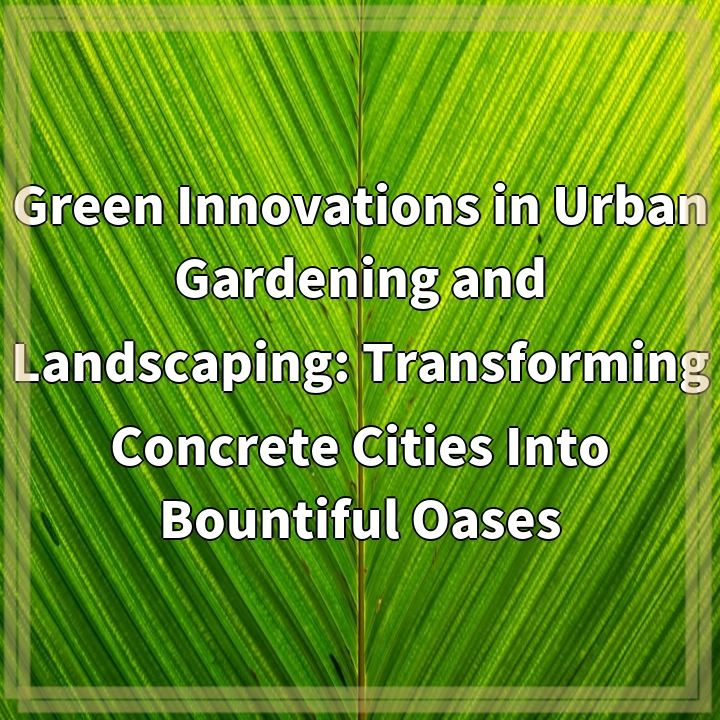
What it is:
Urban gardening and landscaping refer to the practices of growing plants and creating green spaces in urban areas where open land is limited. It involves innovative techniques and designs to maximize the use of available space and resources. These green initiatives aim to bring nature into concrete cities, creating havens filled with plants, trees, and wildlife. Urban gardening and landscaping provide numerous benefits, not only for the environment but also for the well-being of urban dwellers.
Real-world problems:
Limited Space:
One of the challenges of urban gardening and landscaping is the limited space available for planting and creating green areas. In cities with high population densities, finding suitable locations for gardens and parks becomes a significant hurdle. Urban planners and designers need to find creative solutions to utilize every inch of available space, such as rooftop gardens, vertical gardens on walls, and community gardens in empty lots.
Lack of Greenery:
Concrete jungles often lack greenery, leading to a multitude of issues. The absence of plants and trees results in reduced air quality, higher temperatures due to the heat island effect, and limited habitat for urban wildlife. Urban gardening and landscaping initiatives aim to address this problem by introducing vegetation in parking lots, along sidewalks, and in other urban spaces. Green roofs and living walls are innovative solutions that enhance biodiversity and improve overall quality of life in urban areas.
Access to Land and Resources:
Securing land for urban gardening and landscaping projects can be challenging. In many cities, there is a scarcity of available land, and acquiring suitable plots can be expensive. Additionally, ensuring access to water, especially in arid regions, can be a significant hurdle. Sustainable practices, such as rainwater harvesting and utilizing recycled water, can help overcome these resource limitations and make urban greening projects more feasible.
Social and Economic Inequality:
Urban gardening and landscaping initiatives can face challenges related to social and economic inequality. Disadvantaged communities often lack access to green spaces and may not have the resources or knowledge to engage in urban gardening. To ensure equitable access to these initiatives, it is crucial to provide education, training, and support to underprivileged communities, empowering them to participate and benefit from urban greening projects.
Maintenance and Sustainability:
Ensuring the long-term maintenance and sustainability of urban gardening and landscaping projects is vital. Without proper care and attention, green spaces can deteriorate and lose their intended benefits. Lack of funding, community engagement, and knowledge about appropriate maintenance practices can be barriers to sustaining these projects. Implementing effective management strategies and involving the community in the maintenance process are crucial for the long-term success of urban greening initiatives.

Solutions:
Maximizing Space:
To overcome the limited space challenge, urban gardening and landscaping can utilize innovative techniques like vertical gardens, rooftop gardens, and community gardens. These techniques make efficient use of available space, allowing more greenery to be incorporated into urban areas.
Integrating Greenery:
To address the lack of greenery in concrete cities, urban greening initiatives should prioritize the integration of plants and trees in various urban spaces. This can involve planting trees along sidewalks, creating pocket parks, and implementing green roofs and living walls. By actively incorporating vegetation, cities can enhance air quality, mitigate heat island effects, and provide habitat for urban wildlife.
Sustainable Resource Management:
Efficient resource management is crucial for the success of urban gardening and landscaping projects. Rainwater harvesting, utilizing recycled water, and implementing sustainable irrigation practices can help mitigate water scarcity issues. Additionally, incorporating composting practices and organic fertilizers can contribute to the sustainability of these initiatives.
Promoting Equity and Inclusion:
To ensure equity and inclusion, urban greening projects must prioritize engagement with underprivileged communities. This can involve providing education, training, and resources to enable disadvantaged communities to actively participate in gardening and landscaping initiatives. Collaborative efforts and community involvement can contribute to the success and sustainability of projects while fostering social cohesion and empowerment.
Building Long-term Partnerships:
To sustain urban gardening and landscaping projects, it is essential to establish long-term partnerships and engage the community. Collaborating with local municipalities, businesses, and organizations can provide ongoing support, funding, and resources. Involving the community in the maintenance and management of these projects fosters a sense of ownership and ensures their long-term success.















